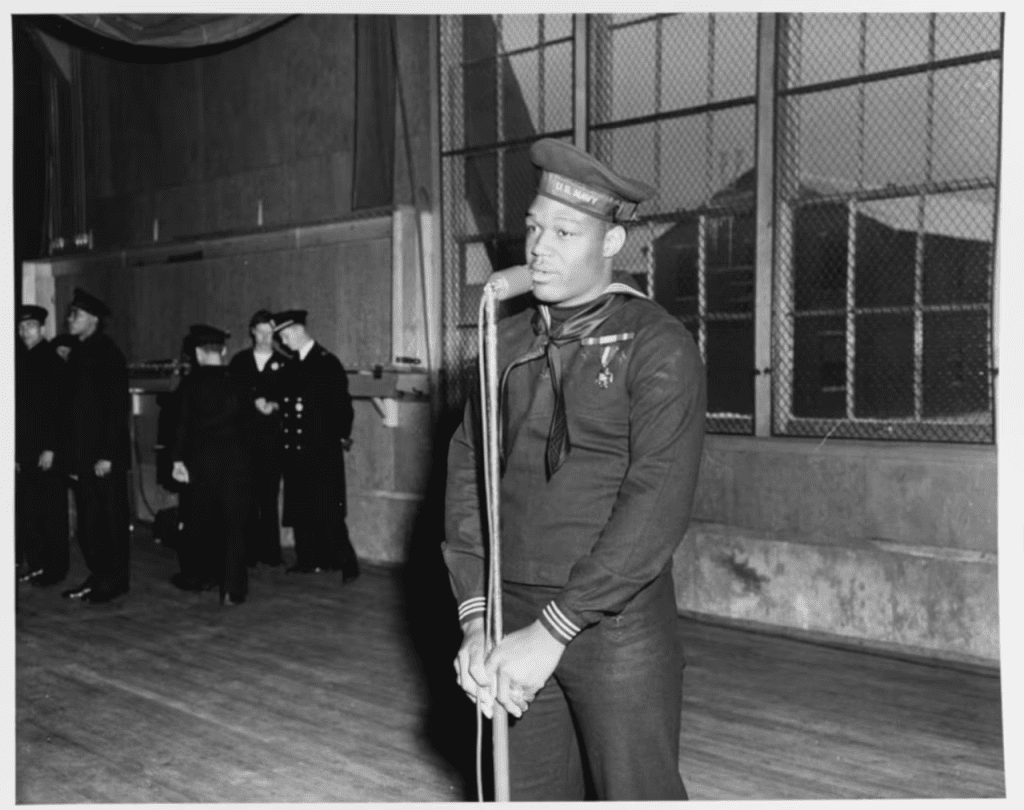When history speaks of heroes, it often conjures names of high-ranking officers or decorated generals. But on December 7, 1941, during the attack on Pearl Harbor, one of the most inspiring acts of bravery came from a man who wasn’t even trained for combat a young Black sailor named Doris “Dorie” Miller. In just 15 minutes, he transformed from a humble mess attendant into a national symbol of courage and change.

A Sailor Without a Gun… Until It Mattered Most
Doris Miller was born in Waco, Texas, in 1919. Like many African Americans of his time, Miller faced systemic barriers that limited his opportunities, especially in the military. At the time, the U.S. Navy was segregated. Black sailors were typically relegated to menial tasks like cooking, cleaning, and laundry roles considered “non-combat” and far from the battlefield.

Miller joined the Navy in 1939 and was assigned as a mess attendant on the USS West Virginia. He wasn’t trained in using weapons or given a combat position. But when the Japanese launched a surprise attack on Pearl Harbor, none of that mattered.
Video:
Aircraft carrier to be named after Pearl Harbor hero
Under Fire at Pearl Harbor
On the morning of December 7, 1941, Doris Miller was below deck when the first torpedoes slammed into the battleship. He immediately rushed topside to assist the wounded and help secure the ship. As bombs exploded around him and fires spread across the deck, Miller found himself face-to-face with a machine gun an anti-aircraft .50 caliber Browning, mounted and ready but without a gunner.
Though he had no formal training, Miller jumped into action. He grabbed the weapon and began firing at the incoming Japanese planes. Witnesses say he hit at least two aircraft, though official records did not confirm the kills. Still, his accuracy and composure under intense pressure were undeniable.

The First Black Sailor to Receive the Navy Cross
After the chaos ended, word of Miller’s extraordinary bravery began to circulate. His story captured the attention of both the Navy and the public. In 1942, Admiral Chester W. Nimitz personally awarded Doris Miller the Navy Cross the third-highest honor for valor in combat making him the first African American to receive the prestigious medal.
His actions not only made him a war hero but also a trailblazer. At a time when Black servicemen were often invisible within the military’s hierarchy, Miller’s recognition challenged the norms and began a slow but crucial shift toward racial equality in the armed forces.

A Symbol of Patriotism and Progress
Doris Miller’s heroism went far beyond the battlefield. For many Black Americans, he became a beacon of pride a living contradiction to the racism and segregation they endured daily. His courage showed that patriotism isn’t confined to rank or race; it lives in anyone willing to rise when duty calls.
Video:
Pearl Harbor”Doris Miller Plane Kill A.A Gun”[FullHD|1080p]
Miller continued to serve in the Navy after Pearl Harbor but tragically died in 1943 when his ship, the USS Liscome Bay, was torpedoed during the Battle of Makin.
His Legacy Lives On
Though his life was cut short, Doris Miller’s legacy endures. Schools, memorials, and naval vessels have been named in his honor. In 2020, the U.S. Navy announced that a future aircraft carrier the USS Doris Miller would bear his name. It will be the first aircraft carrier ever named after an African American and an enlisted sailor.

Conclusion: A Hero in 15 Minutes, Remembered Forever
Doris Miller didn’t ask to be a hero. He didn’t have training, rank, or resources. What he had was heart and in the face of overwhelming danger, that was enough. His story is a testament to the power of courage, the importance of equality, and the truth that heroes can come from the most unexpected places.
When the alarms blared and the bombs fell, Miller didn’t hesitate. He took a stand not for medals or fame, but because it was the right thing to do. And for that, history will never forget him.


